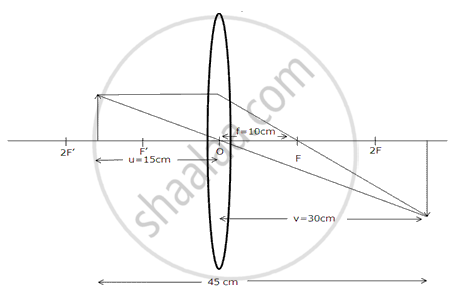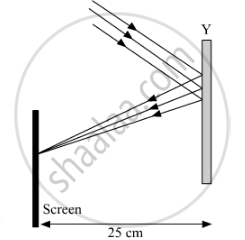Advertisements
Advertisements
प्रश्न
उत्तर

Magnification, m =
⇒ v = 2 u
u + v = 45 cm (given)
u + 2u = 45cm
3u = 45cm
Distance of lens from the object is 15 cm.
⇒ v = 2u = 30cm
We know,
=
⇒ f = 10 cm
Focal length is 10 cm.
APPEARS IN
संबंधित प्रश्न
Draw a ray diagram to show the formation of image in the above situation
A student wants to project the image of a candle flame on the walls of school laboratory by using a lens:-
(a) Which type of lens should be use and why?
(b) At what distance in terms of focal length 'F' of the lens should be place the candle flame so as to get (i) a magnified, and (ii) a diminished image respectively on the wall?
(c) Draw ray diagram to show the formation of the image in each case?
Study the given ray diagrams and select the correct statement from the following:


(A) Device X is a concave mirror and device Y is a convex lens, whose focal lengths are 20 cm and 25 cm respectively.
(B) Device X is a convex lens and device Y is a concave mirror, whose focal lengths are 10 cm and 25 cm respectively.
(C) Device X is a concave lens and device Y is a convex mirror, whose focal lengths are 20 cm and 25 cm respectively.
(D) Device X is a convex lens and device Y is a concave mirror, whose focal lengths are 20 cm and 25 cm respectively.
Where should an object be placed in front of a convex lens so as to obtain its virtual, erect and magnified image?
With the help of a labelled diagram explain how a convex lens converges a beam of parallel light rays. Mark the principal axis, optical centre, principal focus and focal length of the convex lens on the diagram.
Define the term principal axis of a lens.
In the following cases, where must an object be placed in front of a convex lens so that the image formed is at infinity?
To find the image distance for varying object distances in case of a convex lens of focal length 15 cm, a student obtains on a screen a sharp image of a bright object by placing it at 20 cm distance from the lens. After that he gradually moves the object away from the lens and each time focuses the image on the screen.
(a) In which direction-towards or away from the lens does he move the screen to focus the object?
(b) How does the size of image change?
(c) Approximately at what distance does he obtain the image of magnification –1?
(d) How does the intensity of image change as the object moves farther and farther away from the lens?
List four properties of the image formed by a convex mirror.
Observe the given figure and answer the following questions.

- Where is the above type of lens construction used?
- What type of image is formed by an objective lens?
- What happens instead of placing at Fo if the object is placed in between O and Fo?
